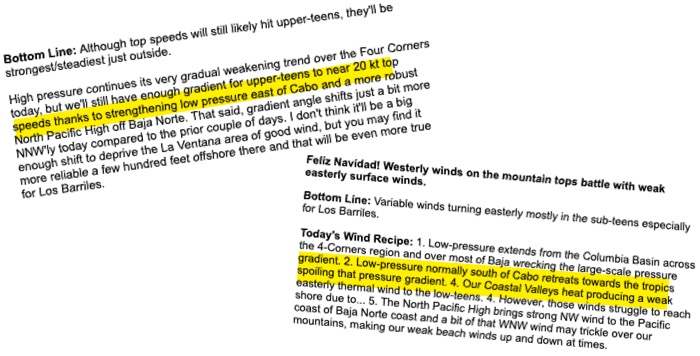
The good news for Baja Weather 101 is that the strongest Sea of Cortez winds in the winter are caused by high pressure in the Four Corners region of the United States.
You can see this high-pressure area in the white isobars circle in the first image.
Notice how the lines get closer together on the Sea of Cortez. The closer the lines are, the stronger the pressure gradient and wind.
But where have all these north winds gone?
Why are there days when there is no high pressure to the north, but the areas of Playa La Sta, La Ventana and Los Barriles have quite strong winds, much stronger than the weak local hot winds?

This happens because of a frequent winter low pressure area, or what the Met calls a “trough,” south of Cabo San Lucas at the top of Baja California.
You'll often see a trough mentioned in the forecast as an integral part of the wind recipe for the day.

When low pressure is located south to southeast of Cabo San Lucas at the tip of the Baja Peninsula, winds from the U.S. high pressure accelerate toward the Sea of Cortez.
The shape and location of this low-pressure system is critical to the strength of winds at Cape Baja East.
1. If the low pressure is too far south, it won't help our winds at all.
2. If the low pressure moves too far north, it will cover the Sea of Cortez. This position destroys the pressure gradient and eliminates wind.

3. But if the low pressure is mostly located south of Cabo, then it will work with the high pressure to produce very strong northerly winds in most sea areas

Cortes.
4. On days when there is no high pressure in the United States, the Rasta Beach, La Ventana, and Los Barriers launch sites typically have only weak, localized thermal winds caused by coastal valley heating. These weak winds have a hard time getting above the teens.
But sometimes, in the United States, wind speeds can reach into the teens with no sign of high pressure. This unpredictable pattern occurs when a trough of low pressure south of Cabo is perfectly positioned.

Unfortunately, most high-resolution models don't cover this area, so it's difficult to pinpoint the low's location. This leads to poor predictions.
